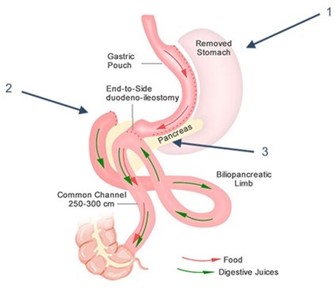Missouri Residents and Blue Cross Blue Shield patients getting care in Missouri: Click here for why Mercy issues notice to Anthem Blue Cross Blue Shield.

Single Anastomosis Duodenal Switch (SADI)
- Home
- Services
- Treatments
- Single Anastomosis Duodenal Switch (SADI)
What is SADI?
Single Anastomosis Duodenal Switch (SADI) is a type of weight loss surgery for people with severe obesity, also known as class 3 obesity. They typically have a BMI of 40 or greater and at least 100 pounds of excess weight.
Severe obesity comes with many health risks, including a shorter life expectancy and serious health conditions like diabetes, high blood pressure, obstructive sleep apnea and other life-changing conditions. For people with severe obesity, the laparoscopic SADI procedure may be the best surgical weight loss option. It results in longer-lasting weight loss and less regain than other types of bariatric surgery.
How Does SADI Work?
The SADI procedure combines sleeve gastrectomy with intestinal bypass to promote greater weight loss. It’s performed by:
After the SADI procedure, you’ll need to follow certain nutritional guidelines. Your bariatric team will provide specific instructions on how much protein and fluid you need. You’ll also need to take vitamins and supplements to prevent malnutrition.
Lifelong follow-up care is required after SADI surgery.
Benefits of the SADI Procedure
You can expect to lose 80% or more of your excess weight after having SADI surgery. Other benefits of the procedure include:
- Restricting meal size
- Bypassing food away from the digestively active part of the gut, which improves metabolism
- Triggering remission of conditions like type 2 diabetes, high blood pressure and obstructive sleep apnea in many people
- Preserving the pyloric valve (where food passes from the stomach to the intestine), which helps decrease bile reflux and stomach irritation
- Requiring only one intestinal bypass, which reduces surgical time and leakage risk
- Decreasing appetite
- Eliminating dumping syndrome that is common with gastric bypass surgery
- Avoiding glucose fluctuations after a meal
- Reducing the risk of gastric ulcers
Potential Disadvantages of the SADI Procedure
As with any surgery, SADI has risks you should know about. Complications may include:
- Bleeding/blood clots
- Dumping syndrome
- Gallstones
- Hernia
- Infection
- Nausea, vomiting, diarrhea or constipation
- Low blood sugar
- Malnutrition or dehydration
- Leaking
- Obstruction
- Spleen or other organ injuries
- Stenosis (narrowing)
- Ulcer (hole)
- Vitamin or mineral deficiencies
SADI After Sleeve Gastrectomy
SADI is sometimes performed for people who’ve had sleeve gastrectomy but didn’t lose the expected weight or have regained weight. It adds an intestinal bypass and may involve reshaping the gastric sleeve if needed. SADI after sleeve gastrectomy offers the same promising weight loss results and remission of obesity-related conditions.

